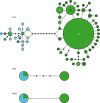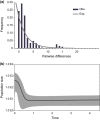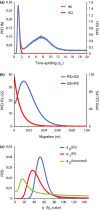Origins of the Greenland shark (Somniosus microcephalus): Impacts of ice-olation and introgression
- PMID: 29043060
- PMCID: PMC5632604
- DOI: 10.1002/ece3.3325
Origins of the Greenland shark (Somniosus microcephalus): Impacts of ice-olation and introgression
Abstract
Herein, we use genetic data from 277 sleeper sharks to perform coalescent-based modeling to test the hypothesis of early Quaternary emergence of the Greenland shark (Somniosus microcephalus) from ancestral sleeper sharks in the Canadian Arctic-Subarctic region. Our results show that morphologically cryptic somniosids S. microcephalus and Somniosus pacificus can be genetically distinguished using combined mitochondrial and nuclear DNA markers. Our data confirm the presence of genetically admixed individuals in the Canadian Arctic and sub-Arctic, and temperate Eastern Atlantic regions, suggesting introgressive hybridization upon secondary contact following the initial species divergence. Conservative substitution rates fitted to an Isolation with Migration (IM) model indicate a likely species divergence time of 2.34 Ma, using the mitochondrial sequence DNA, which in conjunction with the geographic distribution of admixtures and Pacific signatures likely indicates speciation associated with processes other than the closing of the Isthmus of Panama. This time span coincides with further planetary cooling in the early Quaternary period followed by the onset of oscillating glacial-interglacial cycles. We propose that the initial S. microcephalus-S. pacificus split, and subsequent hybridization events, were likely associated with the onset of Pleistocene glacial oscillations, whereby fluctuating sea levels constrained connectivity among Arctic oceanic basins, Arctic marginal seas, and the North Atlantic Ocean. Our data demonstrates support for the evolutionary consequences of oscillatory vicariance via transient oceanic isolation with subsequent secondary contact associated with fluctuating sea levels throughout the Quaternary period-which may serve as a model for the origins of Arctic marine fauna on a broad taxonomic scale.
Keywords: Greenland shark; Somniosus microcephalus; elasmobranch; interspecific gene flow; introgressive hybridization; isolation with migration.
Figures




Similar articles
-
Development and characterization of thirteen novel microsatellite markers for use in Greenland sharks (Somniosus microcephalus), with cross-amplification in Pacific sleeper sharks (Somniosus pacificus).BMC Res Notes. 2021 Jan 19;14(1):28. doi: 10.1186/s13104-021-05447-5. BMC Res Notes. 2021. PMID: 33468214 Free PMC article.
-
Biology of the Greenland shark Somniosus microcephalus.J Fish Biol. 2012 Apr;80(5):991-1018. doi: 10.1111/j.1095-8649.2012.03257.x. J Fish Biol. 2012. PMID: 22497371 Review.
-
First recorded occurrence of the parasitic barnacle (Anelasma squalicola) on a Greenland shark (Somniosus microcephalus) in the Canadian Arctic.J Fish Biol. 2023 Jul;103(1):189-193. doi: 10.1111/jfb.15421. Epub 2023 May 10. J Fish Biol. 2023. PMID: 37102263
-
Essential and non-essential element concentrations in two sleeper shark species collected in arctic waters.Environ Pollut. 2007 Jul;148(1):281-90. doi: 10.1016/j.envpol.2006.10.039. Epub 2006 Dec 19. Environ Pollut. 2007. PMID: 17182159
-
An assessment of the toxicological significance of anthropogenic contaminants in Canadian arctic wildlife.Sci Total Environ. 2005 Dec 1;351-352:57-93. doi: 10.1016/j.scitotenv.2005.01.051. Epub 2005 Sep 12. Sci Total Environ. 2005. PMID: 16154621 Review.
Cited by
-
Plastid genome and its phylogenetic implications of Asiatic Spiraea (Rosaceae).BMC Plant Biol. 2024 Jan 3;24(1):23. doi: 10.1186/s12870-023-04697-8. BMC Plant Biol. 2024. PMID: 38166728 Free PMC article.
-
Mitochondrial DNA sequencing of a wet-collection syntype demonstrates the importance of type material as genetic resource for lantern shark taxonomy (Chondrichthyes: Etmopteridae).R Soc Open Sci. 2021 Sep 15;8(9):210474. doi: 10.1098/rsos.210474. eCollection 2021 Sep. R Soc Open Sci. 2021. PMID: 34540250 Free PMC article.
-
Development and characterization of thirteen novel microsatellite markers for use in Greenland sharks (Somniosus microcephalus), with cross-amplification in Pacific sleeper sharks (Somniosus pacificus).BMC Res Notes. 2021 Jan 19;14(1):28. doi: 10.1186/s13104-021-05447-5. BMC Res Notes. 2021. PMID: 33468214 Free PMC article.
References
-
- Andersen, L. W. , & Born, E. W. (2000). Identifications of two genetically different sub‐populations of Atlantic walruses (Odobenus rosmarus rosmarus) in West and Northwest Greenland. Canadian Journal of Zoology, 78, 1999–2009.
-
- Andersen, L. W. , Born, E. W. , Gjertz, I. , Wiig, Ø. , Holm, L. , & Bendixen, C. (1998). Population structure and gene flow of the Atlantic walrus (Odobenus rosmarus rosmarus) in the eastern Atlantic Arctic based on mitochondrial DNA and microsatellite variation. Molecular Ecology, 7, 1323–1336. - PubMed
-
- Avise, J. C. (1992). Molecular population structure and biogeographic history of a regional fauna: A case history with lessons for conservative biology. Oikos, 63, 62–76.
-
- Bacon, C. D. , Silvestro, D. , Jaramillo, C. , Smith, B. T. , Chakrabarty, P. , & Antonelli, A. (2015). Biological evidence supports an early and complex emergence of the Isthmus of Panama. Proceedings of the National Academy of Sciences of the United States of America, 112, 6110–6115. - PMC - PubMed
-
- Benz, G. W. , Hoffmayer, E. R. , Driggers, E. R. , Allen, W. B. , Bishop, D. , Lougan, E. , & Brown, D. A. (2007). First record of sleeper shark in the western Gulf of Mexico and comments on taxonomic uncertainty within Somniosus (Somniosus). Bulletin of Marine Science, 80, 343–351.
LinkOut - more resources
Full Text Sources
Other Literature Sources

